When thinking of insects, many people add in arachnids and others who do not belong in the category. Insects have six legs, not eight, and they come in a very wide variety of shapes and colors. Some may be able to jump very far, whereas others may fly extremely fast. Insects are incredibly diverse, and many are beneficial to the environment. This also goes for the dangerous insects in the United States. Whether or not we want to admit it, the world could not exist without insects, dangerous or not.
When it comes to humans and insects, the relationship is rocky at best. Over one billion dollars are spent on pesticides in the US annually. Not only are the pesticides terrible for everything that comes in contact with them, but they also end up in our waterways and our oceans. Pesticides are much more dangerous than any insect on the planet, even mosquitos. Let’s learn what insects rank high on the danger scale in the US.
1. Mosquito (Anopheles freeborni and quadrimaculatus)
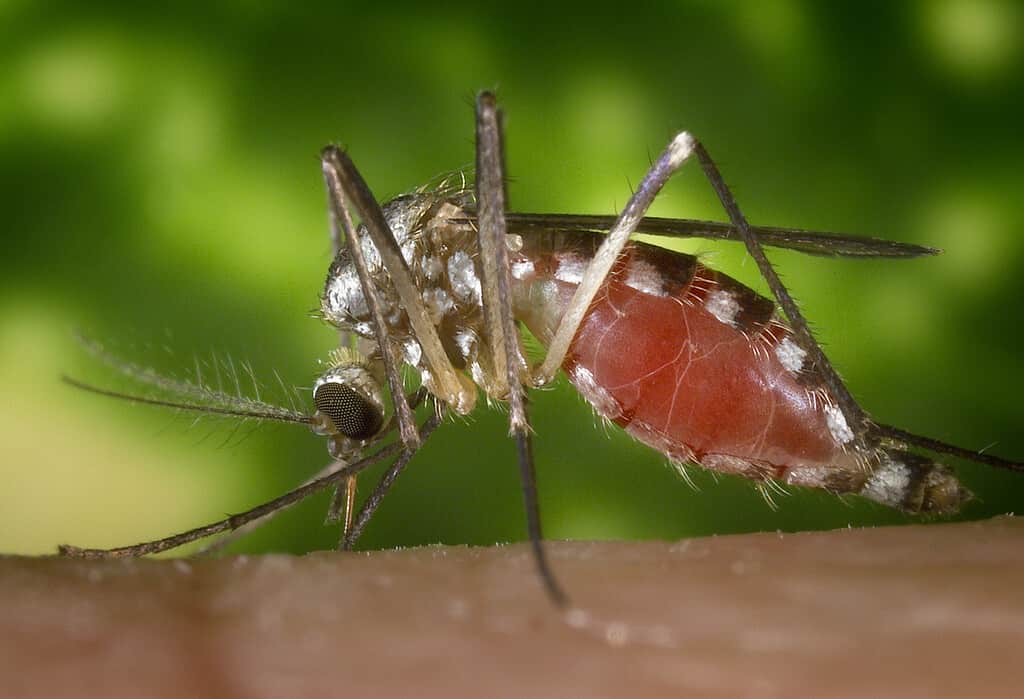
Mosquitos are to blame for the most human deaths per year.
©CDC/James Gathany/CC0 1.0 – License
Appearance: Small, narrow flying insects with long thin legs with long piercing mouthparts.
Size: Less than 1/2 inch long
Dangers: Mosquitos are responsible for the spread of dengue, malaria, chikungunya, and Zika virus outbreaks. They cause 400+ million outbreaks yearly, with around 2.7 million people dying a year.
Interesting Fact: There are 12 types of disease-spreading mosquitos in the US. Mosquitos also kill many dogs per year through heartworms, which is why it is important to have your dog on heartworm prevention.
| Disease | # of US People Infected 2022 | # of US People Dead 2022 | % Increase from 2021 |
|---|---|---|---|
| Malaria | 7 (9/2023) | 0 | 700% |
| Dengue | 1,073 | 0 | 817% |
| West Nile | 1,035 | 79 | Decrease |
| La Crosse | 21 | 0 | Decrease |
| Eastern Equine Encephalitis | 38 (2019) | 19 (2019) | Decrease |
| St. Louis Encephalitis | 32 | Unknown | Decrease |
| Chikungunya | 47 | 0 | 123% |
| Zika Virus | 3 | 0 | Decrease |
2. Deer Tick (Ixodes scapularis)
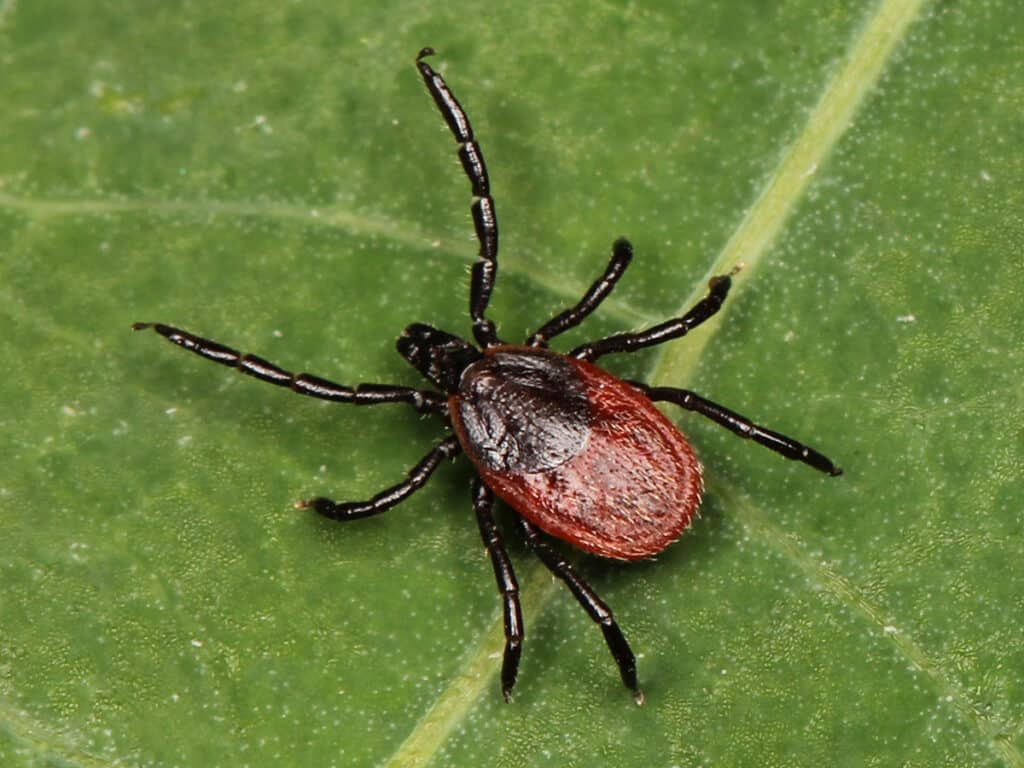
The black-legged tick is also called the deer tick.
©Kaldari / Creative Commons – License
Appearance: Black legs and head with a round black spot behind the head and a chestnut brown for the rest of their body. The males have black legs and a dark brown body.
Size: The adults are 2 – 6 millimeters long, but the nymphs, which are the size of a poppy seed, can go undetected.
Dangers: Lyme Disease, which causes fatigue, joint issues, severe headaches, stiffness, heart palpitations, drooping on one side of the face, inflammation of the brain and spinal cord, nerve pain, and other unpleasant side effects that can appear for days to months after the bite.
Interesting Fact: The black-legged tick, commonly known as the deer tick, only lives in the northeastern, mid-Atlantic, and northcentral areas of the US. A tick found in the central part of the county rarely carries Lyme Disease. Generally, the tick must remain attached to its host for 36 – 48 hours for Lyme Disease to take hold.
3. Kissing Bug (Triatominae)
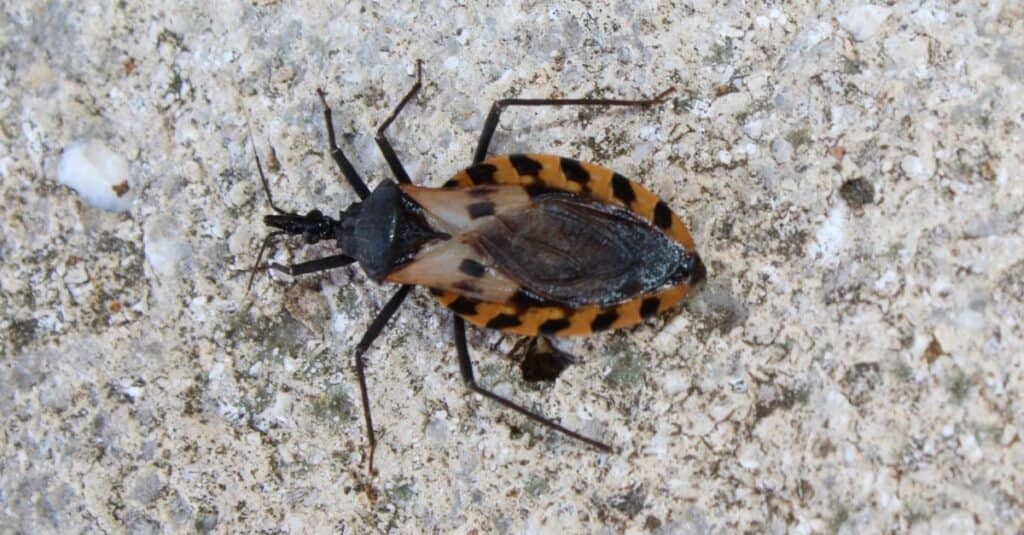
Assassin bugs, or “kissing bugs,” get their names from their habit of biting humans on the face near the lips while they sleep.
©Vanessa Becker-Miller/Shutterstock.com
Appearance: They are black or dark brown with red, orange, or yellow around the perimeter of their bodies.
Size: Less than 1 inch long
Dangers: Occasionally, the kissing bugs carry Chagas Disease, which can enter the body if the bug defecates in it. Chagas Disease has an acute and chronic stage. Not everyone has symptoms in the acute stage. The chronic stage can equal heart problems for some people. Dogs can be infected by eating the bugs.
Interesting Fact: Generally, kissing bugs bite around the mouth when you are sleeping, so it is easy to wipe or scratch at the mouth without knowing you were bitten.
4. Human Bot Fly (Dermatobia hominis)
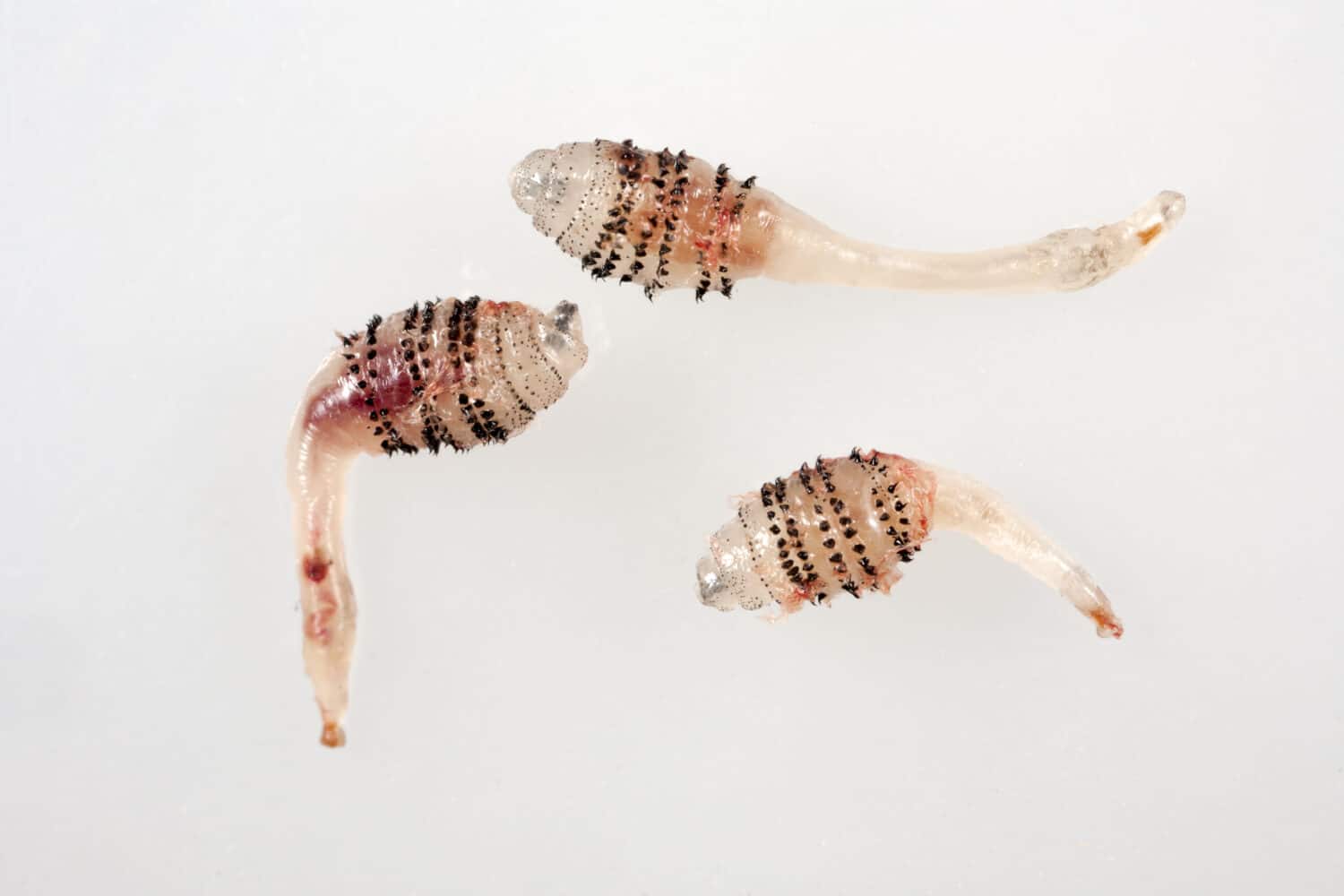
Bot flies can cause serious issues in small animals.
©Tacio Philip Sansonovski/Shutterstock.com
Appearance: They have a yellow face with a metallic blue abdomen and orange legs. The flies look like small bumblebees.
Size: They are 12 – 18 millimeters long
Dangers: They can create a raised lesion in which they have laid their eggs. Once they hatch, they can be felt under the skin. After the larva matures, they burrow out of the skin.
Interesting Fact: Bot flies are attracted to infected tissue and lay their eggs inside of it. The larva eats the infection, which isn’t entirely bad.
5. Helminths or Parasitic Worms

Parasitic worms are harmful to animals and humans.
©Kateryna Kon/Shutterstock.com
Appearance: Invertebrates with long, thin, flat, or round bodies.
Size: Dependent on what type of worm it is, but some can be over 3 feet long.
Dangers: The worms can feed on different parts of the body, including blood, which can cause anemia. They can also cause digestive issues and malnutrition. They can also cause cognitive and physical growth retardation.
Interesting Fact: It is possible to have worms for years without knowing.
6. Tarantula Hawks (Pepsis albocincta)

Tarantula hawks have the most painful sting of any other US wasp.
©iStock.com/Rainbohm
Appearance: The wasps have midnight blue iridescent bodies and bright orange wings. The females have curled antennae, while the males are straight.
Size: Up to 2 inches long
Dangers: They are dangerous and tend to be docile creatures unless you’re a spider. They do, however, pack a very painful sting.
Interesting Fact: The tarantula wasp stings the tarantula, paralyzing it, then drags it back to its nest to lay an egg on it. When the larva emerges, it burrows into the tarantula and eats it.
7. Bed Bug (Cimex lectularius)
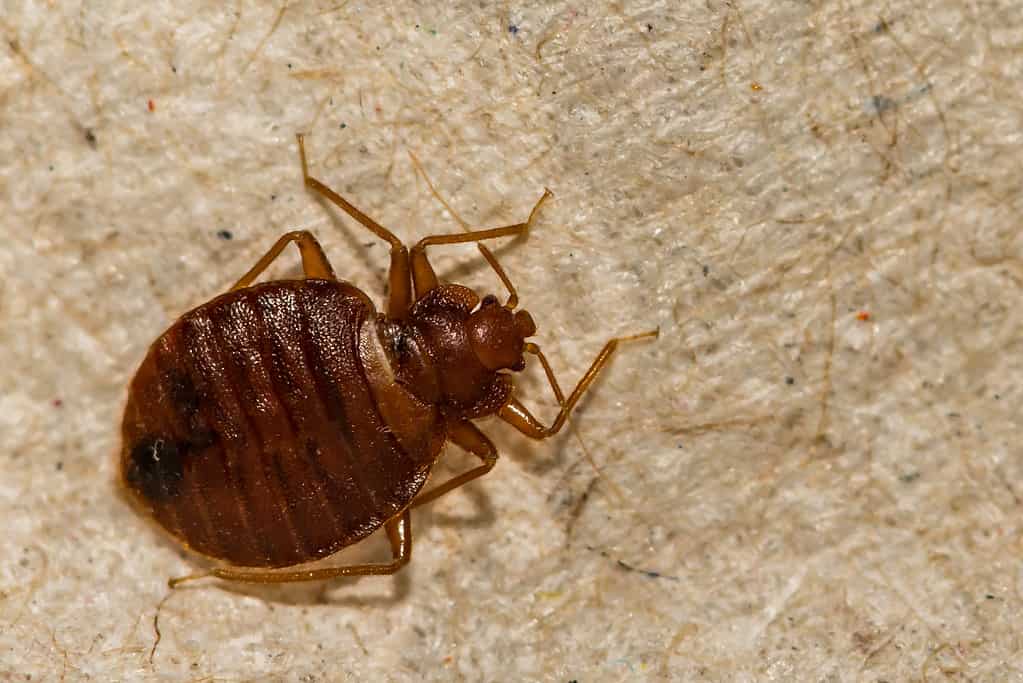
Bed bugs aren’t as harmful as the infections they can cause.
©Jay Ondreicka/Shutterstock.com
Appearance: They have a round, flat body with parallel lines and antennae. The bugs are a dark reddish brown, and when one is found, many others will also be there.
Size: Approximately the size of an apple seed once fully grown.
Dangers: Their bites can become severe with infestations and can lead to blisters and rashes.
Interesting Fact: The bed bugs’ only food is blood.
8. Asian Giant Hornet (Vespa mandarinia)
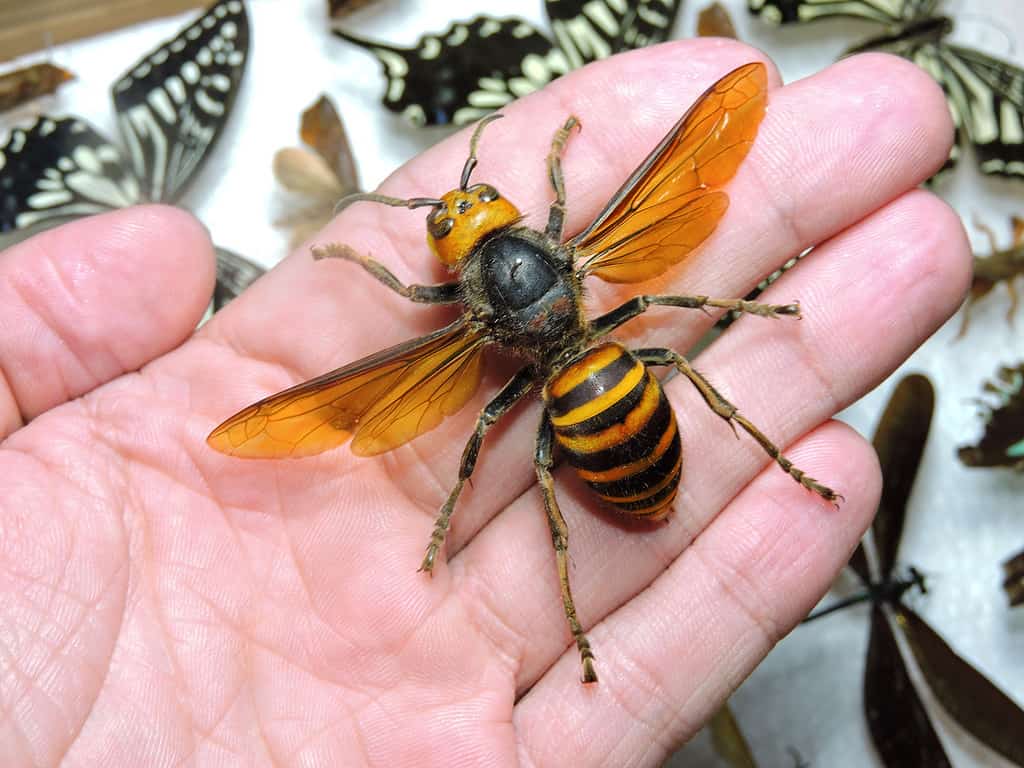
The Asian Giant Hornet is an invasive species that feeds on honeybees in the US.
©iStock.com/Bruno Uehara
Appearance: The hornet has a large yellow-gold head with the same color banding with black around its abdomen. Their wings are translucent yellow.
Size: They are 2 inches long, the largest of hornets anywhere.
Dangers: Like other hornets, these giants can repeatedly sting you and are often found in multiples. If there is an allergy to their venom, it can cause anaphylaxis.
Interesting Fact: Before 2019, the US had not seen these hornets.
9. Saddleback Caterpillar (Acharia stimulea)

The saddleback
caterpillar
is a species native to North America and Mexico.
©Hagit Berkovich/Shutterstock.com
Appearance: The caterpillar is pinkish brown to dark brown with a lime green “blanket” on its back and a circular “saddle” in the center of the blanket. The saddle and blanket are outlined in white. It has four large appendages with spikes. There are two on the front, like antennas, and two on the back. They also have six smaller appendages on each side near their feet.
Size: Approximately 3/4 inch long
Dangers: They have hollow spikes connected to venomous glands on the four large appendages that can cause severe discomfort for some sensitive people. It can cause swelling, asthma, stomachache, and itching.
Interesting Fact: The saddleback caterpillar is commonly found on ornamental plants in gardens.
10. Red Imported Fire Ant (Solenopsis invicta)

Stepping on the mound of the fire ants will end with many painful and incredibly itchy bites.
©AOKSANG STUDIO/Shutterstock.com
Appearance: These insects are dark reddish-brown, whereas native fire ants are not uniformly colored.
Size: They are .12 – .24 inches long
Dangers: They attack in large groups and can sting repeatedly. For small children and young or baby animals, this can be dangerous. They also attack native ant species and harm crops.
Interesting Fact: These fire ants are native to South America.
11. Yellowjacket (Vespula sp.)
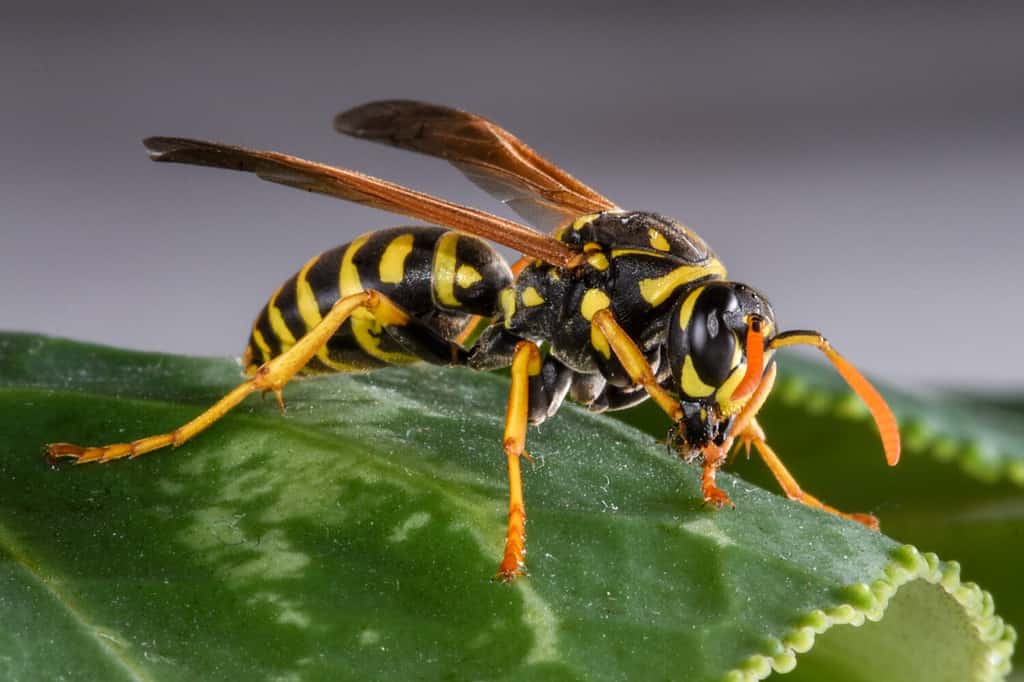
There are 30 – 40 types of yellow jackets under the genus
Dolichovespulaand
Vespula.
©Randy Runtsch/Shutterstock.com
Appearance: Most yellowjackets have a black and yellow striped abdomen, whereas others have red and black or black and white striped abdomens.
Size: Typically 1/2 – 1 inch long
Dangers: Some make underground burrows, and when they are stepped on, they will come out and can sting repeatedly. Their stings cause severe pain and redness. Anaphylaxis can occur with many stings.
Interesting Fact: Some yellowjackets’ nests can weigh as much as half a ton.
12. Puss Caterpillar (Megalopyge opercularis)

Once the puss caterpillar becomes an adult, it takes the form of a very fuzzy Southern flannel moth.
©Chase D’animulls/Shutterstock.com
Appearance: Small brownish, grey, light orange, or whitish-haired caterpillar looking a bit like Cousin It from The Adams Family, only with a mohawk or faux-hawk. The hair stands up a bit down the center and tapers in the back. At least it’s not a mullet-hawk. They may look cute and cuddly, but they are the opposite. They are also cute and fuzzy when they become Southern flannel moths.
Size: Up to 1 inch long.
Dangers: The small bristly hair on the caterpillar’s body is none other than urticating hairs, which can cause severe discomfort. The hairs can become embedded in the skin and will cause pain and burning. In some sensitive people, the hair can cause trouble breathing, severe rash, and nausea.
Interesting Fact: The puss caterpillar is named for appearing cat-like and soft. They are the most venomous caterpillars in the country.
13. Velvet Ant or Cow Killer (Dasymutilla occidentalis)

Like their cousins, the wasp, only female velvet ants can sting.
©Tarsal Claw/Shutterstock.com
Appearance: Typically reddish orange with a black band around their abdomen along with black legs, black underside, and black in between segments of their body. They look like very large fuzzy ants. The males are similar but have dark-colored wings and different color patterns on their abdomens.
Size: Up to .75 inches long
Dangers: Velvet ants are not aggressive but will sting if threatened. Their sting is one of the most painful in the country, which is what earned them the name “cow killer,” though no cow has ever been killed by one.
Interesting Fact: The velvet ant isn’t an ant at all but is a wasp without wings. Also, the velvet ants make a squeaking or chirping sound when alarmed.
14. Blister Beetle (Meloidae)
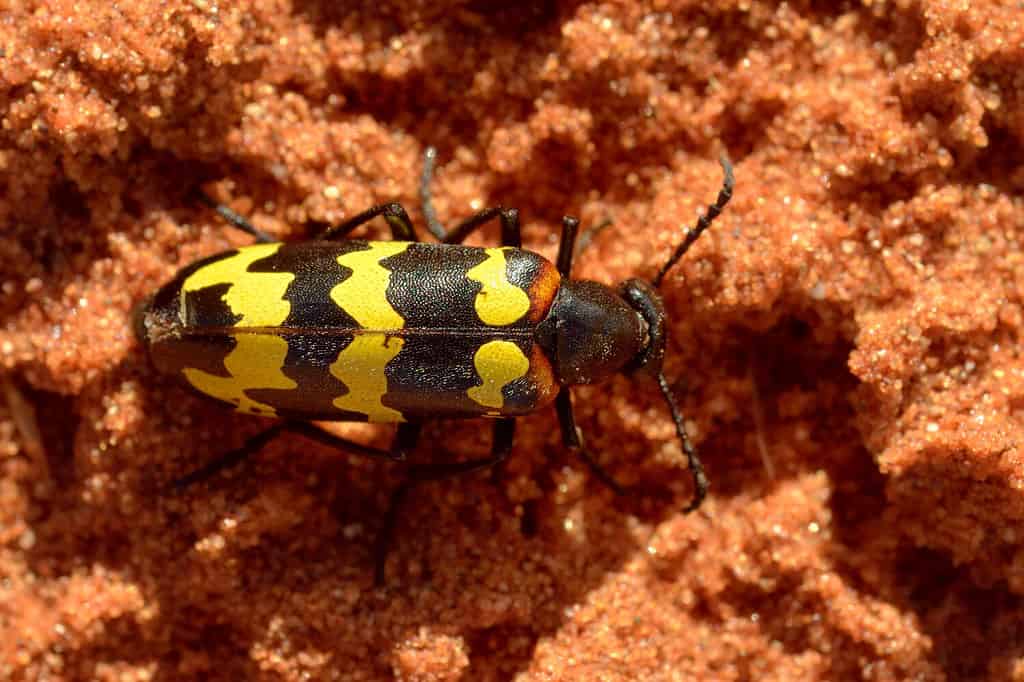
Because of their ability to produce caustic chemicals, they are sometimes utilized in traditional medicine.
©D. Kucharski K. Kucharska/Shutterstock.com
Appearance: They vary widely in coloring, and some have stripes. The beetles have a soft body and broad head. The covering over the wings is soft. They are long and thin, similar to lighting bugs.
Size: They are 1/2 – 1 inch long.
Dangers: The beetles excrete cantharidin, which can cause severe irritation and blistering when it comes in contact with the skin, eyes, or digestive tract. They can cause very serious issues if they are ingested by hay-eating animals.
Interesting Fact: There are over 7,500 types of blister beetle.
15. Wheel Bug (Arilus cristatus)

Wheel bugs are in the assassin bug family, which also includes kissing bugs.
©samray/Shutterstock.com
Appearance: Brownish grey insects with a spiky half-wheel shape on their thorax. They have long legs and generally move slowly. Their mouth extension is reddish-orange
Size: 1 – 1.5 inches long.
Dangers: If handling is attempted, the wheel bug will bite, inflicting a very painful wound that becomes numb and can last for days.
Interesting Fact: This is the only type of wheel bug found in the US. They are beneficial since they prey on pest insects.
Don’t Touch or Make Angry
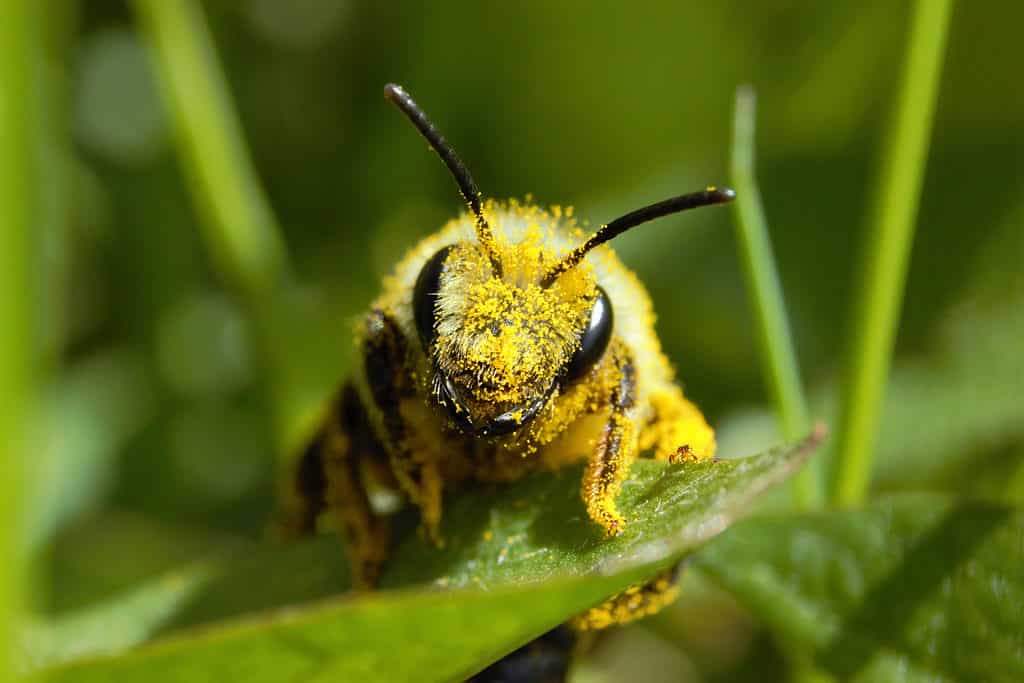
Wildlife is always best left alone. By doing so, you are respecting them and their boundaries.
©David James Chatterton/Shutterstock.com
Many of these insects would never choose to sting or injure you without you first making the first move to threaten them in some way. Insects are very small creatures compared to humans, and they have very little defenses compared to what we are capable of. It is the same with everything in nature; it’s best enjoyed from a distance. Accidents happen when people become too daring and lose compassion for the natural beauty and creatures around them.
Sometimes, it is impossible to know when you are walking across a hornet’s nest or about to grab a spiny caterpillar. Everyone who is allergic or who is uncertain if they are allergic to stings and venom should keep an Epi-pen nearby. Anaphylaxis is not something you want to mess around with.
Always pay attention to your surroundings and take note of what types of animals and insects are nearby. If you must reach blindly into a hole or bush, reconsider. By respecting nature, many times, it will also choose to respect you.
FAQ

The Assassin Bug uses its long proboscis to spear its prey.
©Christian Musat/Shutterstock.com
Q: Which bug will chase you?
A: If you anger hornets, wasps, and sometimes bees, they will chase you. If they are hornets and wasps, chances are that they will sting you multiple times when they catch you. The best thing to do in that situation is to get indoors as quickly as you can. If you are far from the safety of the great indoors, get in anything that can secure you or run. Once you get 200 yards away, they will give up and return to their nest because it is unprotected. If you choose to hide in a shed or car, make sure it is far enough away from their nest that they will give up and fly back to continue to defend it. If you are concerned about the amount of stings you’ve received, call 9-1-1.
Q: What colors are bees, hornets, and wasps attracted to the most?
A: Bees, hornets, and wasps are attracted to bright colors because they are reminiscent of flowers. It is also suggested to never wear fruity or floral-smelling perfume when you are spending time outside because it puts you more at risk.
Q: Which insect can paralyze a person?
A: Ixodidae ticks, such as the deer tick, very rarely cause temporary paralysis. This only happens if the tick remains attached for several days and secretes a neurotoxin in its saliva while attached to a person.
Q: Which is the most dangerous insect venom in the world?
A: The red harvester ant (Pogonomyrmex maricopa) found in Arizona is the most toxic venom by quantity in the world. The LD50 (lowest dosage required to kill 50% of the mice subjected to it) is a mere .12mg/kg. This is a time to be very thankful humans are much larger than a mouse. This small ant would be otherwise deadly for humans.
The photo featured at the top of this post is © iStock.com/Bruno Uehara
Thank you for reading! Have some feedback for us? Contact the AZ Animals editorial team.






